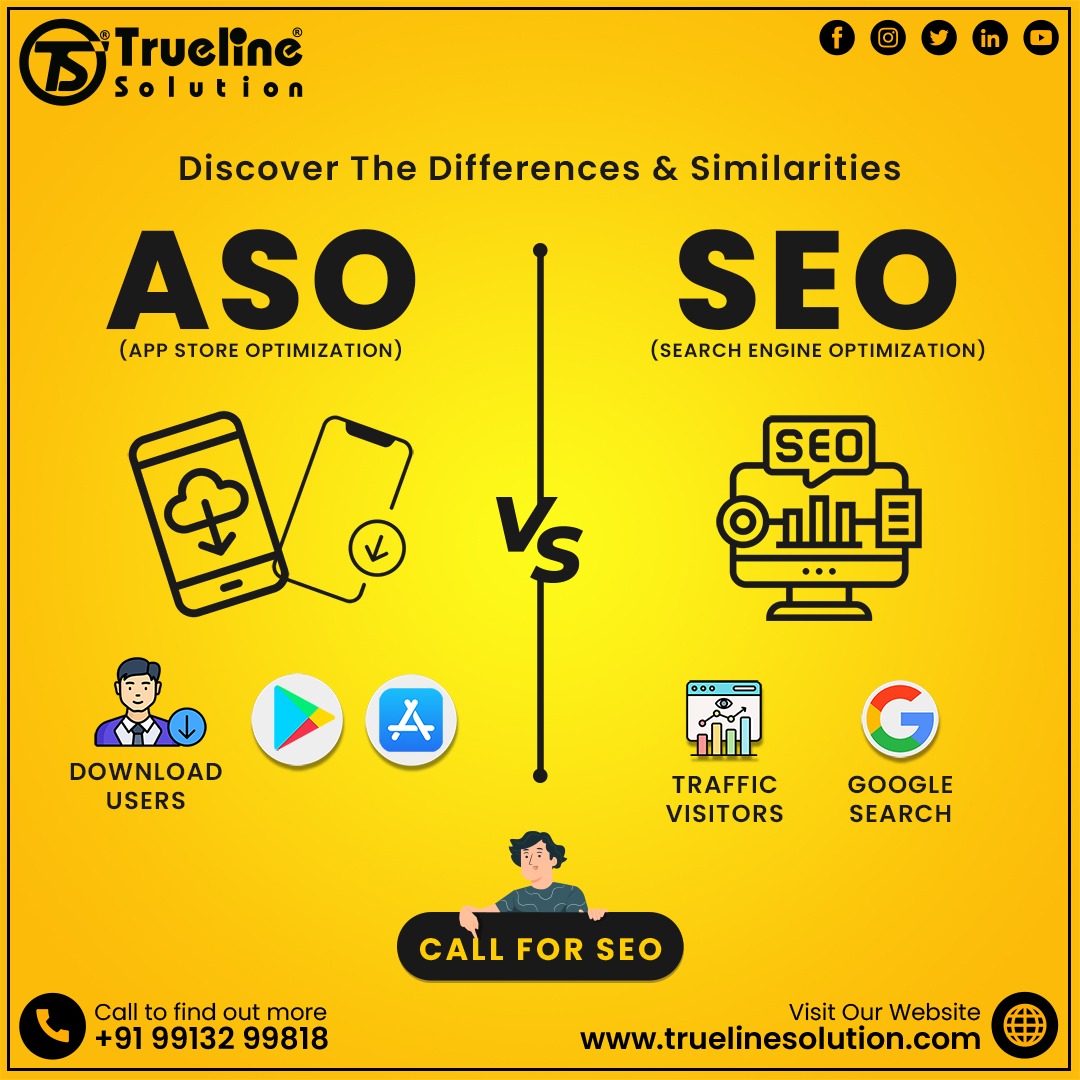0 Comments

ASO and SEO: Discover the Differences & Similarities
In the digital age, businesses must leverage every available tool to stand out in a crowded marketplace. Two critical strategies that often come into play are App Store Optimization (ASO) and Search Engine Optimization (SEO).
While both aim to increase visibility and drive traffic, they operate in different arenas and have unique techniques. Let's explore the differences and similarities between ASO and SEO to better understand how each can benefit your business.
Understanding ASO and SEO
App Store Optimization (ASO) focus on improving the visibility of mobile applications in app stores, such as Google Play Store and Apple's App Store. The goal is to rank higher in app store search results and top charts, thereby increasing downloads and user engagement.
Search Engine Optimization (SEO), on the other hand it improve a website's visibility in search engine results pages (SERPs) like Google, Bing, and Yahoo. By optimizing web content, keywords, and backlinks, SEO strives to attract more organic traffic from search engines.
Key Differences Between ASO and SEO
|
Key Points |
ASO |
SEO |
|
Main Goal |
Higher App Store Rank |
Top Web Search Results |
|
Search Engine |
Google Play |
Google Search |
|
Apple App Store |
Bing |
|
|
- |
Yahoo |
|
|
User Experience |
Intuitive App Interface |
Seamless Site Navigation |
|
Keyword Strategy |
App Related Keywords |
Web Search Keywords |
|
KPls |
Downloads |
Click – Through Rate |
|
User Retention |
Traffic |
|
|
On Page |
App Name [ Title] |
Title Tag |
|
Description |
H1, H2, H3 |
|
|
Keywords [ IOS] |
Keyword Density |
|
|
Usage & Quality Metrics |
Page Speed |
|
|
Uninstall Rate |
Bounce Rate |
|
|
Off Page
|
Backlinks |
Links |
|
Ratings & Reviews |
Anchor Text |
|
|
Download Stats |
Social Signals |
|
|
Target Audience |
App Store Users |
Diverse Online Audiences |
Platform and Purpose
ASO is specific mobile app stores. It involves optimizing app titles, descriptions, icons, screenshots, and reviews to boost app rankings.
SEO is broader, targeting search engines. It encompasses optimizing website content, meta tags, images, and building quality backlinks to improve rankings and drive web traffic.
Metrics for Success
ASO success is measured by app downloads, user ratings, reviews, and rankings in app store search results.
SEO success is gauged by organic traffic, search engine rankings, click-through rates (CTR), and conversion rates.
Similarities Between ASO and SEO
Keyword Research :
Both ASO and SEO rely heavily on keyword research. Identifying the right keywords is crucial to understanding what terms potential users or customers are searching for. These keywords should be strategically incorporated into app titles, descriptions (for ASO), and web content, meta tags (for SEO).
Optimization Techniques :
Optimization is at the core of both ASO and SEO. This involves continuously refining and improving various elements—whether it's an app's title and description or a website's content and structure—to enhance visibility and performance.
User Experience :
Both ASO and SEO place a significant emphasis on user experience. For ASO, this includes ensuring the app is user-friendly, has an appealing design, and functions smoothly. For SEO, this involves creating a website that is easy to navigate, loads quickly, and is mobile-friendly.
Analytics and Monitoring :
Continuous monitoring and analysis are vital for both ASO and SEO. Using analytics tools, businesses can track performance, identify areas for improvement, and adjust strategies accordingly to maintain and improve rankings.
ASO and SEO: Ranking Factors
App Store Optimization (ASO) Ranking Factors
1. App Title and Subtitle:
The app title and subtitle are critical for ASO. Including relevant keywords in these elements can significantly impact your app’s visibility in app store searches. A well-crafted title and subtitle not only improve rankings but also convey the app’s purpose to potential users.
2. Keywords:
Keywords play a central role in ASO. The app store's algorithm uses these keywords to determine your app’s relevance to search queries. Conducting thorough keyword research and strategically placing these keywords in your app’s metadata is essential for improving rankings.
3. App Description:
While not as heavily weighted as the title and keywords, the app description still plays a role in ASO. A well-written, keyword-rich description can help improve visibility and encourage downloads by clearly communicating the app’s features and benefits.
4. Ratings and Reviews:
User ratings and reviews are crucial for ASO. High ratings and positive reviews not only boost your app’s credibility but also influence its ranking in the app store. Encouraging satisfied users to leave positive reviews can significantly impact your app’s performance.
5. Downloads and Engagement:
The number of downloads and user engagement levels (such as active usage and retention rates) are important factors for ASO. Apps with high download numbers and active users are more likely to rank higher in app store searches.
Search Engine Optimization (SEO) Ranking Factors
1. Keywords:
Keywords are fundamental to SEO. Identifying and incorporating relevant keywords into your website’s content, meta tags, and headings is crucial for ranking well in search engine results pages (SERPs).
2. Content Quality:
High-quality, informative, and engaging content is essential for SEO. Search engines prioritize content that provides value to users. Regularly updating your website with fresh, relevant content can help improve your rankings.
3. Backlinks:
Backlinks from reputable websites signal to search engines that your website is credible and authoritative. Building a strong backlink profile through quality content and outreach can significantly enhance your SEO rankings.
4. Page Load Speed:
The speed at which your website loads affects user experience and SEO rankings. Search engines favor websites that load quickly. Optimizing images, leveraging browser caching, and minimizing code can help improve page load speed.
5. Mobile-Friendliness:
With the increasing use of mobile devices, having a mobile-friendly website is critical for SEO. Search engines prioritize websites that offer a seamless mobile experience. Ensuring your site is responsive and easy to navigate on mobile devices can boost your SEO performance.
How ASO and SEO Complement Each Other
While ASO and SEO operate in different spaces, they can complement each other effectively. For businesses with both a mobile app and a website, a cohesive strategy that integrates both ASO and SEO can maximize visibility across platforms. Here’s how:
Unified Branding: Consistent use of keywords, design elements, and branding across your app and website can create a unified digital presence, enhancing user recognition and trust.
Cross-Promotion: Promote your app on your website and vice versa. Encourage website visitors to download your app for a better user experience or exclusive features, and use your app to drive traffic to your website for detailed content and additional services.
Holistic User Engagement: Engaging users across both app and web platforms can provide a seamless experience, increasing overall user satisfaction and loyalty.
Conclusion
In conclusion, both ASO and SEO are essential strategies for improving visibility and driving traffic in their respective domains. By understanding the differences and similarities between ASO and SEO, businesses can effectively utilize both to achieve their goals. Whether you’re optimizing an app for the app store or a website for search engines, focusing on keywords, user experience, and continuous improvement will lead to success.





Leave a Comment
Your email address will not be published. Required fields are marked *